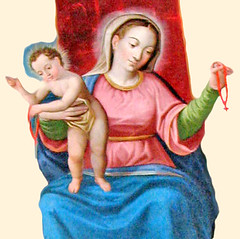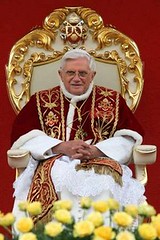Bread Broken for Others

The account in St Matthew of the feeding of the five thousand (Mt 14:13-21) is often seen as a Eucharistic text. In St John's gospel, the account of the multiplication of loaves is followed by the unique discourse on the Bread of Life (cf Jn 6). As such, the five loaves and two fish was an Eucharistic symbol utilised in early Christian art. The most famous example is the 6th century mosaic shown here, found on the floor of the church in Tabgha - which by ancient tradition is where Jesus performed this miracle - which depicts two fish and only four loaves in a basket... The fifth loaf is the Eucharistic bread which is Christ broken for others. This mosaic is situated directly in front of the altar of this ancient church, showing clearly the understanding of the early Church that the miracle in today's Gospel is an allusion to the Eucharist. Other images of the church in Tabgha which is in the care of the Benedictines may be viewed here.
As such, the Eucharist fulfills the prophecy of Isaiah, recounted in today's First Reading (55:1-3), for it is the Food that satisfies our hunger and thirst for life. Moreover, the Eucharist is a renewal of the "everlasting covenant" (Isa 55:3) promised to David. There are resonances in St John's gospel to this passage, wherein Jesus compares the Bread of Life which satisfies to that which does not: "Just as the living Father sent me and I have life because of the Father, so also the one who feeds on me will have life because of me. This is the bread that came down from heaven. Unlike your ancestors who ate and still died, whoever eats this bread will live forever" (Jn 6:57-58). As such, Jesus, the Bread of Life, is He who satisfies the "desire of every living thing" (Ps 145:16). That fact that one need only call on the Lord of compassion to be filled and need not earn this bounty nor give renumeration for It tells us how of the gratuity and goodness of Christ's love for us. This love of Christ is abiding and conquers our every fear and adversity, as St Paul says in the Second Reading. Moreover, the providence of God is over-abundant, for after all have been satisfied, twelve full baskets are left over. Is it significant that there are twelve baskets? I would suggest that it is. Perhaps they allude to the Church which is founded on the Twelve apostles and it is often said that the Church makes the Eucharist and vice versa. Or perhaps they allude to the heavenly Jerusalem which is founded on the Twelve and has Twelve gates (cf Rev 21:12-14) and the Eucharist is that foretaste of the heavenly banquet within the heavenly city. As such, these twelve baskets contribute to the Eucharistic imagery and our understanding of the Eucharist.

But returning to our Gospel, we see clearly the concern of Christ and his compassion for people. The Lord has rather touchingly sought some quiet and time alone after the death of his cousin, St John the Baptist, perhaps to grieve the loss of his kinsman and to pray. As such, "he withdrew in a boat to a deserted place by himself". However, this is not possible. The crowds follow him and seeing them and their need, the Lord is moved by pity to cure them, feed them and instruct them; he gives them what they need, satisfying their desires. How ineffable is God's love for us! How wonderful the example of Christ! I have known too of priests who simply are unable to find time to even grieve or find time for themselves, so great are the demands of their ministry. Like the Lord they serve and imitate, these priests give of themselves out of compassion and love for their flock.
The Lord's concern for the people extends to fulfilling their physical needs too. He not only heals them of their ailments, he also feeds them for they are hungry. Thus, while we rightly give the miracle a spiritual and Eucharistic interpretation, one must not lose sight of the very practical reality of the situation. This unity of matter and spirit is integral to the Eucharist and indeed, the sacramentality of the Church and the Incarnation of Christ. Therefore the Church cannot simply be satisfied with giving spiritual solutions to life's problems and dilemmas. One is not being called upon to satisfy one's physical hunger on the Eucharist alone (although this impression may be falsely gleaned from the First Reading!) As such, the Church has always sought to feed the poor and starving, alleviate the pains and sufferings of humanity and serve the material needs of humanity alongside her preaching of the Gospel and the salvation of souls. This unity of body and spirit is essential. The example of Blessed Teresa of Calcutta comes to mind, who strived to meet the practical needs of the poor while staying grounded in the spirituality of her mission, which was to encounter Christ in them and to save them by loving them as Christ does. It is this reaching out in love to others that serves (in part) to remind our suffering brothers and sisters of the constant love of Christ proclaimed so resoundingly in the Second Reading (Rom 8:35, 37-39).
This two-fold dynamic of being fed by the Eucharist and the Word and thus to be enabled to serve the poor and needy is expressed by Pope John Paul II in his Apostolic Letter 'Dies Domini'. I therefore end by quoting His Holiness:
"Receiving the Bread of Life, the disciples of Christ ready themselves to undertake with the strength of the Risen Lord and his Spirit the tasks which await them in their ordinary life. For the faithful who have understood the meaning of what they have done, the Eucharistic celebration does not stop at the church door. Like the first witnesses of the Resurrection, Christians who gather each Sunday to experience and proclaim the presence of the Risen Lord are called to evangelize and bear witness in their daily lives. Given this, the Prayer after Communion and the Concluding Rite — the Final Blessing and the Dismissal — need to be better valued and appreciated, so that all who have shared in the Eucharist may come to a deeper sense of the responsibility which is entrusted to them. Once the assembly disperses, Christ's disciples return to their everyday surroundings with the commitment to make their whole life a gift, a spiritual sacrifice pleasing to God (cf. Rom 12:1). They feel indebted to their brothers and sisters because of what they have received in the celebration, not unlike the disciples of Emmaus who, once they had recognized the Risen Christ "in the breaking of the bread" (cf. Lk 24:30-32), felt the need to return immediately to share with their brothers and sisters the joy of meeting the Lord (cf. Lk 24:33-35)."

The photo above shows students from my class in the Philippines distributing porridge to the neighbourhood poor as part of a Lenten project. They had fasted and saved money for this project.







0 Comments:
Post a Comment
<< Home